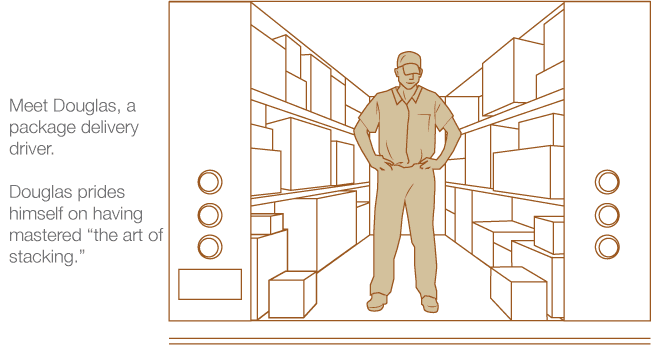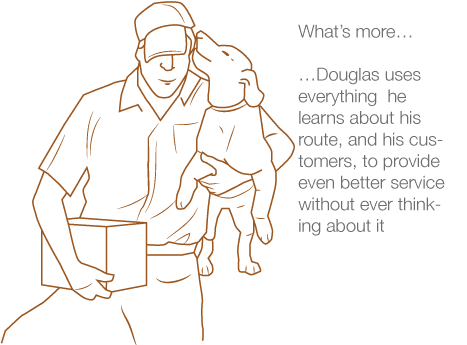Delivery Driver App
Great design leaders recognize that they need user researchers who can draw on the framework of Lean and rapid contextual research to engage in Lean Ethnography. They rapidly identify unmet user needs, and emotional connectors to a product or service. They ensure the product is intuitive, satisfying, and delightful. I call this model my Logical-Emotional Experience Paradigm, a term similar to what Tim Parsey, former VP of UX at Yahoo articulated back in 2011. More recently Kelly Goto, a tremendously gifted researcher and leader of an agency that cares deeply about developing products that users love, codified this model even more clearly. Following this model, researchers and designers create experiences that create a positive engagement for their users. At the same time, they support users in completing real objectives efficiently.
Figure 1: Jim's Logical Emotional Design Paradigm
Lean Ethnography- What Is It?
Recently when talking with a User Research leader who I respect deeply, I said tongue-in-cheek that I will probably never hire another traditional user researcher. To my surprise, she agreed! Don’t get me wrong. UX teams need to understand user needs, and ultimately to find the key emotional connectors to your product. The reality though is that we can draw on the framework of lean processes and rapid contextual research to engage in Lean Ethnography.
The reality is that having the right features that are usable is just foundational. We also need to understand the factors that drive a positive or negative emotional connection to our products.
Finding Logical, Emotional Drivers
User research has to identify the logical and the emotional drivers of users’ connections to a product and brand. People cannot often express why they are emotionally connected to something. They just love it or they hate it. If we can meet users’ deeper emotional needs, they will defend our products beyond logic. You may be familiar with the phrase (attributed widely to Mark Twain) “You cannot displace, through logical argumentation, a position that was arrived at emotionally.” We want people to defend us emotionally, and logically. What one company can you think of that customers support beyond any rational position? That is a company whose profits will continue to soar.
The question then is whether we can create products that are easy to use, but also beautiful, that feel fantastic to touch and use. Can we have products that are intuitive, satisfying, and delightful? We can, and it doesn’t need to take months.
I love the way Samsung conducted research into how they could connect on a deeper emotional level to their users, so they would love the new Samsung Galaxy III and later phones. In the end, the Galaxy rivals the iPhone for market share, so the research paid off.
Lean Ethnography- A Case Study
The issue here is that Lean for design and engineering needs to mean lean for UX Research as well. UX Researchers need to find new ways to gather the right data fast. Saying “sorry, we can’t respond with data in the next two weeks 10 days, because the research will take 3 months minimum” is seldom the right answer.There are cases when it should take this long, but they are increasingly rare. Some researchers will say “Jim, you don’t get it,” and I’m completely OK with that. We won’t work together. Let me share an example.
Last year, this very issue arose: I prompted my team to think up the next generation device user experience for their delivery service drivers in seven days. Now, the researchers on the project told me it would take at least a month to conduct the user research to provide data to inform a high-quality vignette. We just didn’t have a month. We had a couple days to gather research and five work days to prepare our solution. Rather than walk away, we did some guerilla research: We ordered several pick-ups and deliveries from a delivery service in a two-day period. We observed the drivers, and asked numerous questions, so we could very rapidly understand their context of use, their current challenges, their goals, both explicit and implicit, and what connects them emotionally to their current process, good and bad. In doing so, we were able to create the vignette, or visual story, highlighting a new mobile solution in five days. As part of our research, we learned about the drivers’ conscious goals, and their unconscious goals, their obvious challenges, and their unstated challenges.
In the following vignettes, we highlight the recommended solution, as well as some of the key emotional motivators for these delivery drivers. After creating this visualization, we then work with the engineering team to define what is technically feasible. So, rather than the technology being defined first, we envision the solution first, then define how we can achieve this vision. Of course, there are tradeoffs, but in the end, these vignettes highlight the desired experience, which can help guide the product development team.
Now, what if we could capture all of Douglas' tacit knowledge...
then add technology to it?
Framework
Our two key design drivers: Contextual knowledge and efficiency.
- The less the driver has to look at the device, the better.
- Time used in navigating and interacting with the device is inefficient time.
- The driver needs to focus on the road, on the customer and on looking and understanding his whereabouts.
Contextual Knowledge
The interface automatically adjusts to show what is relevant to Douglas in each step of delivery. Optimizing for driving, carry and delivery.
Efficiency
The route and delivery queue shifts automatically to the conditions on road and driver’s location. The driver is not burdened with unnecessary data and the most important thing is always highlighted.
Driving on Main St
Parking on Oak Street

Selecting 3 Packages for 123 Oak

Scan 3 Packages for 123 Oak

Carrying 3 Packages to 123 Oak


Setting Packages on the Porch

Record Packages Left on the Porch

Alternate- Record that the Customer Picked Up the Package

Deliveries Complete. New Alert

Next Five Deliveries

Tacit knowledge + technology creates value

Summary of Screens

In this example, the team captured these insights and created these vignettes to highlight a possible experience outcome for the user, and for the end customer, of the new technology solution. We did so in a total of six days. Thus, gathering deep insights and crafting an intended experience outcome can take very little time, and it can provide significant value. Once we had the vision right, we could move to defining features and the technology to support the experience outcome, and delight our users, customers, and shareholders.





